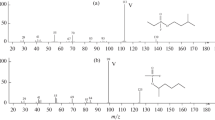Abstract
Recent investigations have shown that oestrogens are converted to water soluble metabolites by liver tissue. From this fraction, the 1- und 4-glutathione thio-ethers of 2-hydroxyoestrogens have been identified. In the present communication, methods are described for the isolation, separation and identification of the thio-ethers from biological material. These methods consist of column chromatography on Sephadex, high voltage paper electrophoresis and mass spectrometry. The formation of various derivatives, suitable for mass spectrometry, is discussed. The most suitable compounds were found to be the trimethyl silyl derivatives whose fragmentation is described in detail. By means of mass spectrometry, the 1- and 4-thio-ethers of 2-hydroxyoestrogens can be easily distinguished from each other. The amount of substance, necessary for recording good mass spectra, varies between 1 and 5 μg.
Zusammenfassung
Untersuchungen der letzten Jahre haben gezeigt, daß Oestrogene in der Leber zu wasserlöslichen Metaboliten umgewandelt werden. Unter diesen Verbindungen konnten die 1- und 4-Glutathionthioäther der 2-Hydroxyoestrogene identifiziert werden. In der vorliegenden Arbeit werden Verfahren zur Isolierung, Trennung und Identifizierung der Thioäther aus biologischem Material beschrieben. Die Verfahren bestehen aus Säulen-Chromatographie an Sephadex, Hochspannungspapierelektrophorese und Massenspektrometrie. Es werden verschiedene Verfahren zur Darstellung geeigneter Derivate für die Massenspektrometrie diskutiert. Als am besten geeignet erwiesen sich die Trimethylsilylderivate, deren Fragmentierung an Hand von Beispielen erläutert wird. Mit Hilfe der Massenspektrometrie können die 1- und 4-Thioäther der 2-Hydroxyoestrogene einwandfrei voneinander unterschieden werden. Der Substanzbedarf für die Aufnahme gut auswertbarer Massenspektren liegt zwischen 1 und 5 μg.
Similar content being viewed by others
Literatur
Agarwal, K. L., Kenner, G. W., Sheppard, R. C.: J. Am. Chem. Soc.91, 3096 (1969).
Breuer, H.: Vitam. Horm.20, 285 (1962).
Elce, J. S.: Biochem. J.116, 913 (1970).
Jellinck, P. H., Elce, J. S.: Steroids13, 711 (1969).
—, Lewis, J., Boston, F.: Steroids10, 329 (1967).
Kamerling, J. P., Heerma, W., Vliegenhart, J. F. G.: Org. Mass Spectrom.1, 351 (1968).
Kuß, E.: Z. Physiol. Chem.350, 95 (1969).
Marks, F., Hecker, E.: Z. Physiol. Chem.350, 69 (1969).
Teeter, R. M.: Abstracts, Tenth Conference on mass spectrometry of the American society for testing materials, p. 51. New Orleans, La. 1962.
Author information
Authors and Affiliations
Additional information
H.-O. Hoppen, Dissertation Math.-Nat. Fakultät, Univ. Bonn 1970.
Die vorliegende Untersuchung wurde mit Unterstützung des Bundesministers für Bildung und Wissenschaft sowie der Stiftung Volkswagenwerk durchgeführt.
Rights and permissions
About this article
Cite this article
Hoppen, H.O., Siekmann, L. & Breuer, H. Identifizierung von Aminosäure- und Peptidconjugaten von Oestrogenen mit Hilfe der Massenspektrometrie. Z. Anal. Chem. 252, 299–304 (1970). https://doi.org/10.1007/BF00571356
Received:
Issue Date:
DOI: https://doi.org/10.1007/BF00571356




